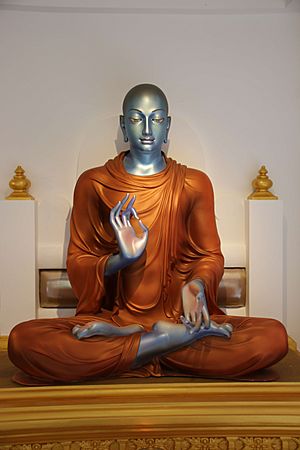Maudgalyayana facts for kids

Statue of Moggallana, depicting his dark skin color (blue, black).
|
|
| Religion | Buddhism |
|---|---|
| School | all |
| Dharma names | (Mahā) Moggallāna Thera, Maudgalyāyana Sthavira |
Quick facts for kids Personal |
|
| Born | year unknown Kolita village, Magadha (today in the Indian State of Bihar) |
| Died | c. 486 BCE Kālasilā Cave, Magadha |
| Parents | Mother: Moggalī, father: name unknown |
| Senior posting | |
| Title | Foremost disciple, left hand side chief disciple of Sakyamuni Buddha; second chief disciple of Sakyamuni Buddha |
| Religious career | |
| Teacher | Sakyamuni Buddha |
| Students | many, including Rāhula Thera or Rāhula Sthavira |
Maudgalyāyana, also known as Mahāmaudgalyāyana, was one of the Buddha's closest students. He was a good friend of another student named Śāriputra. People often see them together in Buddhist art. They are known as the Buddha's two main male students.
Stories say that Maudgalyāyana and Śāriputra started looking for spiritual truth when they were young. They learned about the Buddha's teachings from some famous verses. Later, they met the Buddha and became monks. Maudgalyāyana became enlightened soon after this.
Maudgalyāyana was known for his special powers. He often used these powers to help people learn. He also helped bring the monk community back together after a problem. Maudgalyāyana died when he was 84 years old. Buddhist stories say his death was linked to bad actions in a past life.
Contents
Maudgalyāyana's Special Powers
Maudgalyāyana was famous for his amazing psychic powers. He could do many incredible things. He often used these powers to teach others. For example, he could travel to other worlds. He could also see things far away.
These powers helped him explain the Buddha's teachings. He showed people how the world works. He also helped them understand karma. His abilities made him a very special teacher.
A Close Friendship
Maudgalyāyana and Śāriputra were very close friends. They were both top students of the Buddha. They worked together to spread the Buddha's message. In many pictures, you see them standing next to the Buddha.
They had different teaching styles. Maudgalyāyana used his special powers. Śāriputra was known for his wisdom. Together, they made a great team. They helped many people learn about Buddhism.
Helping the Monks
There was a time when the monk community had a big problem. A monk named Devadatta caused a split. He tried to create his own group. This made the community divided.
Maudgalyāyana played a key role in fixing this. He used his powers and wisdom. He helped bring the monks back together. This was very important for the future of Buddhism. He made sure the community stayed strong.
The Ghost Festival
Maudgalyāyana is also known for his great love for his mother. Stories say he used his good deeds to help her. This led to a special tradition. It is called the Ghost Festival.
During this festival, people honor their ancestors. They do good deeds and share the good energy. They hope this helps their ancestors find peace. This tradition is very popular in many Buddhist countries. It shows the importance of family love.
Finding Ancient Relics
In the 1800s, something exciting happened. An archaeologist found some old bone fragments. These were believed to belong to Maudgalyāyana. They also found some from Śāriputra.
These special items are called relics. They are very important to Buddhists. People travel far to see them. They honor these relics as a way to remember Maudgalyāyana. It shows how much he is still respected today.
Images for kids
-
Śāriputra and Maudgalyāyana became monks with the Buddha.
-
Archaeologist Alexander Cunningham found relics of Maudgalyāyana.
See also
 In Spanish: Maudgalyayana para niños
In Spanish: Maudgalyayana para niños





